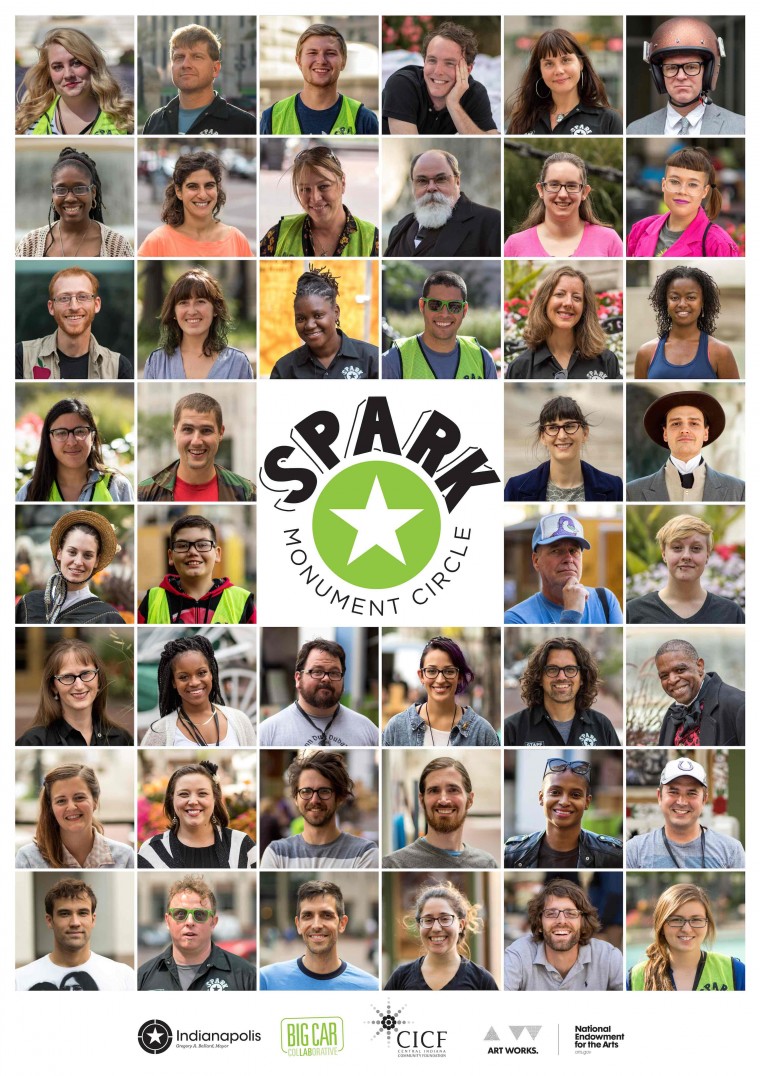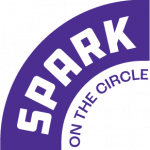By Chris Schumerth, Spark writer in residence
During the next several weeks, if you walk or drive by the sidewalk space in front of Emmis Communications on Monument Circle at about noon on Tuesday, you are likely to see a green “Ask an Expert” booth. If you stop, you will enjoy a lunch hour of lively conversation, probably learn a few things about an interesting topic, and maybe even find that you have your own expertise to offer the city of Indianapolis.
That’s what the IUPUI Arts and Humanities Institute hopes for, anyway. Led by IUPUI history professor Jason Kelly, the Institute is currently collaborating with Big Car’s Spark Monument Circle art and placemaking project. “Ask an Expert” both brings experts of various topics and fields to Monument Circle, while also inviting submissions of expertise (or “trade secrets”) from Indianapolis residents, the results of which will be published collectively online.
For example, Kelly is working on his own project called “Rivers of the Anthropocene.” He said the question most people ask him is: what does Anthropocene even mean?
Sounds like a fair question. The term was coined by Russian scientists in the 1960s, and, as Kelly explained, refers to a measurable geological layer of the earth that was significantly influenced by human behavior. Kelly’s project proposes an exploration of international rivers as systems and calls specifically for collaboration between scientists and the humanities.
“It’s going to cost a lot of money to create some of the changes we need to make,” Kelly said. “But Indianapolis can do better.”
But all “Ask an Expert” conversations are not about the Anthropocene. Upcoming topics include “Art Therapy” with Juliet King (September 15), “Christianity and Globalization” with Joseph Tucker Edmonds (September 22), “Art and Anthropology” with Fiona McDonald (September 29), “Women in Politics with Kristy Sheeler” (October 6), and “Science Fiction and Philosophy” with Jason Eberl (October 13).
I sat down this past Tuesday with Dr. Ray Haberski, another IUPUI professor. Like Kelly, Haberski is an intellectual historian, which means he is interested in the history of ideas. The author of a number of books – including Evangelization to the Heart: A Brief History of American Franciscans and Media, God, and War: American Civil Religion since 1945 – Haberski was at the booth to talk about “God and Country.”
As an example of the kind of issues he’s interested in, he brought up Kim Davis, the Kentucky Clerk who was recently jailed for refusing to issue marriage licenses to same-sex couples. Or on the opposite end of the spectrum, he also mentioned the 1954 decision to insert “under God” into the pledge of allegiance.
What is one to do when he or she finds that his or her religious conviction lands opposite a law? Haberski drew a distinction between religious groups and individuals who happen to be religious. “We can’t outlaw ideas,” he said.
Pete Weldy, the Director of Policy and Research at the Department of Education, and Carla Delagarza, a Legislative Assistant, were on their way to lunch at Chipotle from the Statehouse when they stopped in and brought their own expertise to the discussion.
Haberski quickly turned the conversation to the visitors’ interests, one of which was legislative strategy for Indiana’s minority party, the Democrats.
“We try to win by losing correctly,” Delagarza explained. She also said her party works hard at adding amendments to pieces of legislation that they’re opposed to but which are going to pass.
It was Delagarza’s first time stopping in for a Spark program, but she said she had noticed the programming previously, particularly the As You Wish project that invites people to make a wish that artists make true out of materials they have on hand at Spark.
“Ask an Expert” is one of several programs that make up a creative experiment that aims to treat Indianapolis’s Monument Circle as a park. Spark is funded by a $200,000 Our Town grant from the National Endowment for the Arts in addition to support from CICF and The City of Indianapolis. The programming started at the beginning of August and continues through Oct. 16. During that time, you will find activities bustling from 11 a.m. to 8 p.m., seven days a week.




